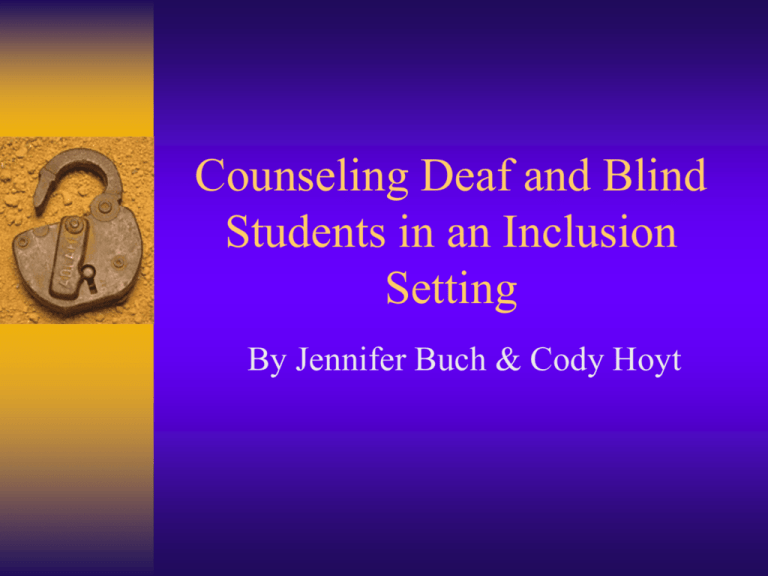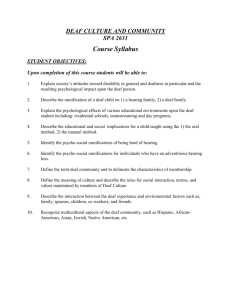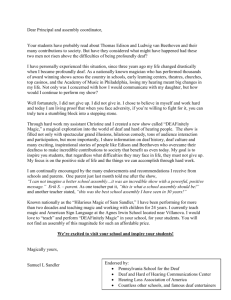Educating children who are deaf or hard of hearing: Inclusion.
advertisement

Counseling Deaf and Blind Students in an Inclusion Setting By Jennifer Buch & Cody Hoyt Deaf Statistics 54 million disabled Americans (U.S. Civil Rights Commission, 1998) 28 million - 52% - identified as deaf/hard-of- hearing (1998) Deaf/hard-of-hearing comprise the largest chronic physical disability group in the U.S. Deaf Statistics cont. 25% of deaf students leave high school reading below the second grade level (receive private services after high school) 45% read between the second- and fourth-grade level (receive VR services after high school) 30% read between grades four and twelve and are considered candidates for college (Most services available today are focused on this group) Inclusion Before 1975, 80% of deaf students were being served in special schools Since the passage of PL 94-142 - the Education of All Handicapped Children Act- more than 75% of deaf students are being educated in the public schools (1996) Point to Consider It is not enough to just be able to communicate with Deaf clients and students; it is essential that counselors understand and accept the social and cultural considerations that the Deaf bring into a counseling setting. Kinds of Deaf Culturally Deaf Late-deafened Hard of hearing These issues manifest themselves in the communication method and psychological identity of the individual, the relationship to family and the broader community Critical Areas for Consideration Education – issues with placement Family – less than 2% of hearing families will learn ASL; families often feel overwhelmed Rehabilitation – VR services Environment – society stereotypes, exclusion from the deaf community and hearing community Point to Consider Schools provide little to no orientation to deafness for the hearing children, the hearing teachers, and the deaf children Issues for Deaf Students Feelings of loneliness and isolation Relying on teachers and deaf peers rather than on hearing peers for socialization Struggle to gain acceptance Difficulty with decision-making Poor self -esteem Fostering Self-Esteem & Acceptance in Deaf Students Security – a feeling of strong assuredness Selfhood – a feeling of individuality Affiliation – a feeling of belonging, acceptance, or relatedness in relationships that are considered important Mission – a feeling of purpose and motivation in life Competence – a feeling of success and accomplishment in things regarded as important or valuable Security A feeling of strong assuredness. Involves feeling comfortable and safe; knowing what is expected; being able to depend on individuals and situations; and comprehending rules and limits. build a trusting relationship set reasonable limits and rules that are consistently enforced create a positive and caring environment Selfhood A feeling of individuality. Acquiring self-knowledge, which includes an accurate and realistic self-description in terms of roles, attributes, and physical characteristics. reinforce more accurate self-descriptions provide opportunities to discover major sources of influence on the self build an awareness of unique qualities enhance ability to identify and express emotions and attitudes Affiliation A feeling of belonging, acceptance, or relatedness in relationships that are considered important. Feeling approved of, appreciated, and respected by others. promote inclusion and acceptance within the group provide opportunities to discover the interests, capabilities, and backgrounds of others increase awareness of and skills in friendship making encourage peer approval and support. Mission A feeling of purpose and motivation in life. Self-empowerment through setting realistic and achievable goals and being willing to take responsibility for the consequences of one’s decisions. enhance ability to make decisions, seek alternatives and identify consequences aid in charting present and past academic and behavioral performance teach the steps to successful goal-setting. Competence A feeling of success and accomplishment in things regarded as important or valued. Aware of strengths and able to accept weaknesses. provide opportunities to increase awareness of individual competencies and strengths teach how to record and evaluate progress provide feedback on how to accept weaknesses and profit from mistakes teach the importance of self-praise for accomplishments. Blind Facts Legally blind- 20/200 eyesight 90 percent US pop is in some way visually impaired Another word "Low Vision“ Fewer than 1/3 visually impaired are in labor force Increase the use of "School to Work Act of 1994" Program helping transition of blind students to be able to enter the work force. 45% of individuals with visual impairments have HS diploma compared to 80 percent sighted Blind Facts cont. Visually impaired students are often not encouraged to attend higher education, we need to change that. Most campuses will help with their services, but they need to know this. Blind students can often feel isolated, teach other students about being visually impaired so they are aware and may understand each other more. Parents may not know what to do with them, so they may feel isolated from families. Accommodations for the Blind Preferential Seating Exams- Adaptive Tech, reader scribe, extra time, large print, closed circuit TV, Braille, tapes Orientation to classroom, show layout, same with school Use descriptive language, avoid "look at this" Realize that they depend on their hearing, but they are not deaf! Assign a buddy to help with transitions in school building. Large print books Tape classroom lectures References Dew, D.W. (1999). Serving individuals who are low-functioning deaf. Washington DC.: Rehabilitation Services Administration. (ERIC Document Reproduction Services No. ED447639) Easterbrooks, S.R. (1998). Adapting the regular classroom for students who are deaf/hard of hearing. Minneapolis, MN: Council for Exceptional Children. (ERIC Document Reproduction Services No. ED418542) Hard of hearing and deaf students: A resource guide to support classroom teachers. (1994). British Columbia Department of Education, Skills, and Training, Victoria. (ERIC Document Reproduction Services No. ED414711) References cont. Johnson, R.C. & Cohen, O.P. (1994) Implications and complications for deaf students of the full inclusion movement. Washington DC.: Gallaudet Research Institution. (ERIC Document Reproduction Services No. ED380917) Nowell, R, & Innes, J. (1997). Educating children who are deaf or hard of hearing: Inclusion. Eric Digests, E557. (ERIC Document Reproduction Services No. ED414675) Santa Rita, E. (1998). Counselors as esteem builders. (ERIC Document Reproduction Services No. ED418765) References cont. Zieziula, F.R. & Harris, G. (1998) National survey of school counselors working with deaf and hard of hearing children: Two decades later. American Annals of the Deaf. Retrieved June 6, 2005, from http://www.findarticles.com.





